Sarah Cypher's Blog, page 5
July 29, 2014
Turf Wars
I am officially a homeowner now. All these years I’ve seen houses with tiny lawns and thought I’d like to have one, because I could trim it with one of those quiet, quaint little push mowers with the spinning blades. Maybe I got the idea from a Sunday comics page in my childhood. And I’ll say in my defense that I’m not the only one with this notion, because our real estate agent perked up when she first saw the house, exclaiming, “Oh! You can cut it with one of those old-fashioned push mowers!”

Blades versus blades.
Fast-forward about a month to the garden tools aisle of The Home Depot. Erin and I went back and forth for a few minutes–I wanted the $80 quaint push mower. Erin wanted the $200 lawn mower. “Are you nuts?” I asked. “Why make all that noise and waste gasoline on a lawn the size of our living room?” Grumbling, she pushed the cart and me and said, “Fine. Get what you want.” Note: It’s bad when your wife tells you to just do what you want. So I put the mower in the cart. Note #2: Don’t actually do what you want, unless you haven’t realized that you’ve already lost the argument.
Fast-forward to Saturday. I fiddled around on the porch for about twenty minutes and got my new, green Scotts push mower all put together. Lifting it high, I carried it to the grass, admiring how light and simple a machine it was. I set it in the corner of the lawn and aimed it across the twenty feet of high grass, ready to set off toward the garden. Erin was pulling weeds by the fence with her back towards me, indifferent to the machine’s maiden voyage.
I gave the lawnmower a push. It didn’t go. I backed up and gave it a running start, and the handles folded me in half at the gut.
Erin finally turned around, now that there was something interesting to watch. I turned the machine to the side and checked the blades, which whirred easily when there wasn’t four inches of wet ryegrass to slice through. I set the machine down, braced myself, and starting shoving it back and forth all over the corner of the grass and managed to hack a square foot of it down to respectable length.
Fast-forward one final time. After sweating, swearing, stomping off for a while, enduring an I-told-you-so, reengaging with the lawn in a spirit of cold-blooded competition, and at last activating Erin’s native stubbornness in the face of a challenging task, we got the fucking thing cut by Sunday afternoon.
I learned in this process that when it comes to yard work, “quaint” means time-consuming and difficult, and cutting a lawn this way has no redeeming spiritual dimension unless you’re Amish. Also that we have good friends, because our buddy Chris is going to give us his electric lawnmower on extended loan.
July 3, 2014
My piece on the Oakland Triathlon Club in Oakland Magazine
My article on how “a new run-bike-swim club wants to popularize an elite sport for everyone” is on shelves today in the East Bay!

Prez Chris Van Luen talking to kids on our visit to the YMCA in April.
June 30, 2014
S-O-C-K-S: Race report from the California International Triathlon
“Spell socks,” my wife Erin told me, a few months into our relationship. We’d met in lily-white Portland, Oregon, and I was ten years out of my college French classes. The only language I spoke or heard spoken was English.
“S-O-C-K-S,” I recited.
“Congratulations on your first Spanish phrase,” she said.
Eso sí que es: basically, It is what it is. And this was my mantra yesterday, as I ran up and down too many short, steep, gravel hills, feeling the inside seam of my running shoe dig into the scab of a big blister on my toe. The healing blister was from last weekend’s experiment in running sockless, because triathletes are sometimes stupidly obsessed with shaving a few seconds off of their race times. Maybe I will skip the socks, I had thought, and charged out for a four-mile trail run experiment.
During yesterday’s 6.2-mile run, all I wanted was an even-thicker pair of S-O-C-K-S and a Band-Aid, but they probably wouldn’t have added any speed to my wobbly legs. Since the Escape from Alcatraz Triathlon four weeks ago, Coach Raeleigh Harris did a great job of putting my body back together and preparing it to push hard. I had a great swim and set a personal record of 1:11 on the 26-mile bike (just under 22 mph), so by the time I discovered that the run was not even a little bit flat (shock! dismay!), I had no energy left for miracles. I ran an 8:28 pace and watched a bunch of women in my age group pass me. Eso sí que es, I sighed to myself, and hummed along with the faint strains of “Rude” emanating from the direction of the finish line.
The morning had begun at 4:20 with coffee and graham crackers with peanut butter. I’d eaten so much this week while my dad was in town, and washed it down with beer and martinis, that by the time the weekend arrived all I wanted was a diet of air and water. Since none of this was in my nutrition plan, I sipped on Skratch sports drink while I set up my gear on the Oakland Triathlon Club rack, happy to see so many from our club racing together today. The midsummer early-morning was bright and calm, and the waters of Shadow Cliffs lake looked cleaner than they had yesterday.

We raced at the Shadow Cliffs Rec Area outside of Pleasanton, CA.
SWIM:
I warmed up based on Coach Raeleigh’s suggestions, but probably only got about 3-4 minutes of total warmup time in the crowded start corral. As I found a decent position near the front of the inner start buoy, I told myself that this time, this race, I was going to get my head in the game quickly and treat this as a true time trial. The day’s conditions were very good (72-degree water, a mostly flat bike course, and a two-loop run course on a somewhat-shaded trail), and for the first time this season, I was racing a standard international-distance triathlon. Today was about setting a baseline.
The horn sounded, and I got my momentum quickly, swimming almost as hard as I did in Thursday’s training swim for the first couple of minutes; by then, I felt good and didn’t back off much. It was a relief to swim in warm water—but only for the first half, before I grew uncomfortably hot in a long-sleeved wetsuit. I rounded the second buoy shortly afterward, and when I saw how far the final buoy was, I started noticing that my shoulders were getting tired. I don’t think I slowed down TOO much, though, and prodded myself to keep going. My swim time was a little over 28 minutes, and other athletes would agree afterward that the course seemed long; as much as 1.1 miles instead of .93.
BIKE:
Starting out, I played with my gears a lot to find a good cadence. I couldn’t read my Garmin very well and judged cadence by feel, but the data shows I ended up riding mostly in the mid-80s. I stayed in the aero position for the first 20 miles, but as I was running low on water and (probably) on a false flat, I really started to lose steam and experience hip flexor tightness. I stood up on the pedals and tried flushing out my legs that way, then rode about a minute sitting up. After that I felt much better.
A minor annoyance was the aero helmet. I was borrowing it from Erin and had never worn it before (yeah, yeah, I know: never try out new gear on race day). It felt speedy and was mostly comfortable, but it started digging into my forehead around mile 10 and there wasn’t much leeway for adjustment. Also around that time, the helmet was getting hot.
I should note, too, that I told every single person I encountered on the bike, “Good job,” or something similar. Maybe three people answered me. This mutual encouragement is part of the sport, and I was disappointed that so many athletes were so insular. Folks, you can focus, go fast, whatever, but the secret source of energy often comes from a shared word of encouragement. Don’t be a triasshole. This is a hobby, and it’s supposed to be fun.
RUN:
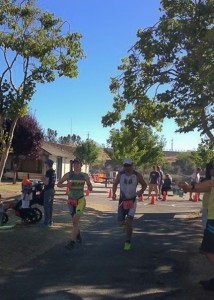
On my second loop of the run.
I didn’t find that my speed or comfort improved after the first 10 minutes, and I really felt my running weakness in this race. The short, steep, gravel hills were irksome, but mostly, I just didn’t have much power to spare after pushing hard on the bike. I focused on my elbows cutting through the air and repeatedly told myself to relax my shoulders. Returning to good form was the only thing that got me through this run: that, of course, and the cheering I got from the OTC volunteers at the first aid station and Erin at the transition area.
Though I kept telling myself to hang on to whatever advantage I’d gained on the bike, a couple of women in my age group passed me and I knew I just had to do my best and my time would be whatever it was. It ended up being better than I expected, and I was still able to push myself and my heart rate to get the most out of what energy I had left. And again, thank goodness for OTC volunteers and their cheering!
When I crossed the finish line, I literally just stopped. My legs were D-O-N-E. For a few moments, I couldn’t move and felt a little stupid, like a cow in the middle of the road or something. The volunteers had to come over to me to get my chip, and give me a finisher’s medal and bottle of water. Finally I remembered how to walk, and after a few minutes of exchanging hugs and congratulations with Erin and teammates, I made my way over to the results.
I may have only finished seventh in my age group, but you can bet that I was third place in line at In-and-Out Burger.
_____
* Thanks for reading this giant block of text! If you were at the race and have a few more pics, feel free to share them with me and I will post them here.
June 6, 2014
In the Name of Neptune’s Nethers: Race Report from Escape From Alcatraz
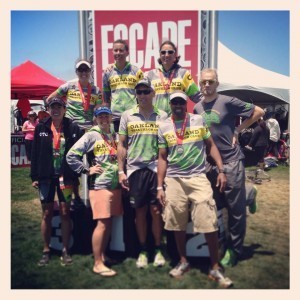
Group mug shot.
My friend, Chris Van Luen of the Oakland Triathlon Club, demanded an answer from me after the Escape From Alcatraz Triathlon. “Sarah Cypher and Erin Lopez: How in the name of Zeus’s butthole do you keep crossing the finish line together!?” After much consideration, a few good nights of sleep, and thorough discussion with my wife, I am compelled to inform Chris that divine nether-regions may be indistinguishable at close range, but the problem orifice on Sunday definitely belonged to Neptune, god of the seas: Erin would have beaten me by several minutes had it not been for the choppy waves separating Alcatraz Island from the swim exit on shore.
By way of context, before the race I told Erin–my training partner, wife, and best friend–that we would probably be separated on the swim. That we would not see each other until later in the race, probably during the run. Unstated was the assumption that I would be the slower swimmer; Erin generally goes faster in races than I do. And the Escape From Alcatraz Triathlon is a tough storm to predict, precisely because its swim is a 1.5 haul across the Bay, with initial cross-currents, winds, and lack of on-course sighting buoys. You can get lucky and use the current to your advantage, or you can be carried off course and miss the exit.
And there was the chaos, too: The last time I saw her before the race started, a volunteer was shoving an athlete over the side of the San Francisco Belle. The athlete disappeared over the bow, and one second later, Erin jumped after her–joining 1,999 other athletes in the 58-degree waters. I was two athletes behind her. Two seconds later, by the time I stepped into the shrill and constant beeping of the timing mats, I was too nervous to pick out her red cap in the thrashing mess next to the boat; I held my goggles to my face, and jumped.
Here’s what happened in the next three hours and five minutes.
Boat:
Rewind a few hours. This part of the race was nothing but raw anxiety. Our contingent of OTC-ers boarded the boat around 5:30 a.m. We didn’t get underway until 6:30, and the race didn’t start until 7:30. The waiting was the worst part. A high fog kept the water almost dead-flat until we approached Alcatraz Island, but the wind picked up, and the water started to get choppy. I stepped out on deck and warmed up with some jumping jacks and shoulder exercises. Ten minutes before the start, I put on my wetsuit, and was mindful to be taking full breaths. As I approached the jump, I got a fix on my first sighting targets (the two towers behind Aquatic Park and the trees of Fort Mason). Erin and I held hands all the way through the mass of gathering athletes, and wished each other a safe, happy race. This is our little prayer that we both say before races, open water swims, and bike rides, because we have both seen our share of accidents over the years; and the promotional materials for this race like to tout the “frigid waters” and “shark-infested Bay,” etc. The athletes around us were almost completely silent, but the scream of timing mats and splash of bodies swallowed the sound of our last few words to each other. Then we were jostled apart, and pushed toward the starting mats.
Swim:
As my golf instructor once told me of my (rather poor) short game in high school, “Ugly, but functional.” As soon as I surfaced from the jump, I got completely battered by the other swimmers and found myself arching my back sharply to sight over the waves. People were nuts. I got kicked, grabbed, pushed under, and jostled—THE WHOLE TIME. And as the wind picked up and threw water into my mouth every other time I breathed, I swallowed a ton of water. Spontaneously, I decided I was never going to swim across the Bay again, but tabled the thought for later because it was a negative one. As cheerily as possible, I talked myself through the choppy parts; and said that it was okay if I couldn’t draft or get into a rhythm at all: Just stay on course and get to land. In relation to the piers next to Fort Mason, it seemed like I was stuck in the same place for a long time—but suddenly I could pick out the dome of the Palace of Fine Arts, and a few minutes later, the red-roofed yacht club beneath it: the target. A three-knot current carried me quickly toward it, and I swam hard directly toward land, exited on the first flat part of shore, and staggered onto the sand.
I looked around for Erin and didn’t see her, and figured that she was somewhere way out in front of me. Next thing I saw were the OTC volunteers cheering like crazy, and Coach Raeleigh Harris holding out a cup of water. I felt better immediately, and rinsed the saltwater out of my mouth as I ran for T1.
T1:
I still assumed Erin was in front of me, but when I saw fellow OTC-er and really good swimmer Angela Yu running out of the transition zone, I knew my swim must have been much better than I thought. (I expected the swim to take 45 minutes, and I’d learn later that I did it in just over 40.) As for my transition time… Sometimes I’m focused, but this time, not so much. I ran in my neoprene swim booties, which allowed me skip the mini-shoe-transition along the water’s edge. I thought this would save time, but I got passed by athletes in shoes on my way to T1. There, I fumbled around with my wetsuit for a while, redid my ponytail because it was falling out, and had a moment when I started putting on my running shoes instead of bike shoes. At that point, I looked up and saw Erin running to her bike. She said hi (but now, later, she says she doesn’t remember seeing me). Anyhow, I felt instant relief, got it together finally, and exited T1 in a glacial time of 7:22.
Bike:
This is a VERY technical bike course, owing to sharp turns, a variety of terrain, headwinds along Ocean Beach, and of course, the hills. If you are aiming to do well in this course, you cannot ride it too much beforehand. Suffice to say, my new fear of wiping out on the downhills held me back, but I was extremely grateful for the two practice rides I attended in the months before (via the Escape Academy and with the Oakland Triathlon Club). I had a 16.7 mph average overall, but could have gone much faster had I not braked so much on the downhills. I was keeping an average of over 22 mph on the flats, and passed a lot of people on the climbs, but they all came flying by me on the downhills, especially after I saw a fallen cyclist getting loaded into the ambulance near the Legion of Honor.
I jockeyed back and forth with teammates Onyanga Dean and Sam Suttle a few times, chatting a little to see how their swims went and how they felt—both were looking really strong. I chased Onyanga for a little while in the hills, but I ran out of steam for a few minutes when I hit the headwind on Ocean Beach (note: next race, I am going to drink more calories as soon as I get on the bike). Onyanga zoomed off into Golden Gate Park, and I used the next 5-10 minutes just to take in some sports drink and recover. Erin caught up to me, whereupon we picked up our pace while talking, and then leapfrogged back and forth on the up- and downhills for the rest of the course. Sam ended up riding with us, too, which made for a very cheerful (and very neon yellow) trio of Oakland riders.
T2:
Got my focus back and kept this one snappy–the only way to make it faster would have been to run harder. I exited T2 about 30 meters in front of Erin.
Run:
I kept an 8:20-ish average on the flats on the way out, having gotten a HUGE boost from the cheering OTC volunteers. My legs felt better than I thought they would; I guess it was true that staying in the aero position on the bike as much as possible would make for a stronger run transition. In short, I felt good, and I kept it together pretty well for the whole run. The sand ladder was tough, of course, but that was the only time I walked. On downhills I ran in the low 7:00 range, and on the flat section to the finish, kept an 8:00 pace. It was there that Erin and Sam caught up to me again, and we paced each other across the finish line. I’d wanted to run an 8:45 average, and managed an 8:42.
So, that was how Erin and I crossed the line together again. Five years ago, I remember our first bike ride together along Marine Drive in Portland, Oregon, and the joy of discovering that we were pretty much the same speed. Across five years and five states, we have been each other’s best training partner. We have different goals—Erin’s is to qualify for the 70.3 championship, and mine is just to have fun racing with OTC and feel good—but the one fact common to all endurance sports is that a race is only the tip of the iceberg. The rest of the time is all training; and there isn’t much that Neptune can throw at us for a measly 1.5 miles that all those thousands of miles on weekends, lunch breaks, and the wee hours of the morning can’t overcome. So, bring it on!
May 5, 2014
Hard as Hill: Wildflower Olympic race report

“Lake” San Antonio, three hours south of Oakland.
I should preface: There is a time and place for boat ramps. They help you get your boat in and out of the water without having to carry it yourself. And if, for some reason, you don’t like to walk in rocks and sand, or can’t take the stairs, a paved ramp into the water is really a clever idea. But if you are organizing an event that requires people to race from the water and run away, putting steep quarter-mile boat ramp in front of them is really a diabolical notion. And let’s actually use TWO boat ramps, somebody said, eyes glinting evilly, because triathletes are masochists.
To put it into perspective, as our brave little band of OTC-ers cheered on the collegiate swimmers yesterday morning, the first young woman to exit the water trudged up the hill at a walk. She was minutes ahead of all the other women, and not too far behind the lead men. She was an amazing athlete and must have swum like a shark. “Unfortunately,” she said, huffing and puffing and grimacing at our congratulations, “I think that’s all I’ve got for today.”
As a matter of pride, I’d promised myself not to walk up Beach Hill. That’s another hill, a steep one-miler at the end of the race. Erin and I agreed that we could walk anywhere else on the course except there. And I was silently thanking myself for that escape clause as I walked up the first boat ramp, because that’s the only time I walked all day.
Let’s fast-forward through the course, GoPro-style: the inky dirty water, the quarter-mile boat ramp, the soft sandy run through the dry lakebed, the second boat ramp, the mile-plus hill that begins the bike course, the two big hills that you climb on the way out and then climb again from the other side on the way back, the stairs out of the transition area, Beach Hill, then the dirt hill that leads to the final blessed descent to the finish line. Today my legs are asking, “What the hill were you thinking?”
I’m thinking that the rest of the season looks easy in comparison, and that I am so happy for everyone who completed the course–especially our mighty Oakland Triathlon Club, who received so much Oakland love from spectators along the course. Before this year, I never felt that I was racing for anything other than to spice up a daily exercise habit with some kind of event; but yesterday our bright kits drew cheers just because of where we’re from, and it reminded me to keep a smile on my face and look strong.
Anyhow, we did well: everybody finished and had fun, and Sam and Onyanga deserve special props for completing Saturday’s long course (which was twice the distance of the Olympic triathlon, and in 92-degree sunshine). Christina Liebner placed second in our 30-34 age group; Erin and I placed eighth and seventh, respectively; Trish Sampson placed seventh in the 40-44 age group, Christina King placed tenth in the 45-49 age group. The club placed eleventh overall, proving that all those workouts in Oakland’s hills are good for something.
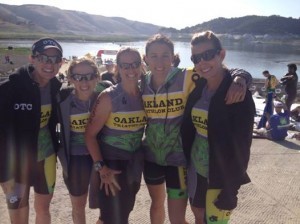
L to R: me, Erin, Jessica Russell, Christina Liebner, and Christina King. (Photo by Jessica)
I have some more work to do, though. My legs are just not strong enough to churn out the level of effort that was needed to get my heart rate up to the correct racing zone. Despite putting out steady effort and following my race plan meticulously, I still topped out in zones 2 and 3 (easy and moderate training zones). If I had pushed any harder to raise my heart rate, I would not have had enough energy to complete the course. That was my biggest limiter yesterday. Another was simply that I wasn’t on a time trial bicycle and lost a couple of minutes because of aerodynamics.
Mentally, I probably could have swum a little harder and smarter, too; I chose a good place close to the buoys that kept me out of the way of other swimmers, but which removed the option to draft off of faster ones. And for some reason, it took me several minutes to get my head in the race–I’d invested so much preparation in the race strategy and peripheral stuff that when the gun went off, I had a hard time believing that it was actually happening. So much for being in the moment. Likewise, on the bike, I felt a little dizzy and disoriented–while I was tucked into the aero position, the sight of the road flying past under my front wheel kept sucking me in, half-hypnotizing me. When Erin passed me at the first water stop, I yelled out, “Wow! I can’t believe this is the turnaround already!” She gave me a funny look, deservedly. The turnaround was still on the other side of two more big hills.
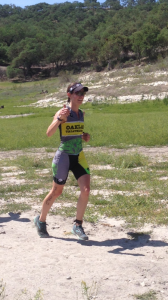
Pure trudgery. Don’t be fooled by the thumbs-up.
Ironically, the more hills I climbed on the bike, the better I felt. On the run I got my legs under me relatively quickly, but at the end of the day, I’m just not that fast. As I realized that my gradual speed gains in training weren’t carrying over to racing, I decided on the fly to just not lose time. I did not walk on Beach Hill or anywhere else (except that evil boat ramp early in the race), and did not walk through water stops. I kept my thoughts positive, although they were fuzzed-out by a lingering sense of wonderment that the race was actually in progress.
I finished in 3:01:something. I really wanted to beat 3 hours, but it was enough to cross the line, get my medal, and turn around just in time to see Erin coming down the finish chute. I’d predicted that we would be no more than two minutes apart. After all, we trained together, shared a race strategy, and started shoulder-to-shoulder in the same age group. But her bike is faster than mine, so maybe next time (ahem) she’ll remember to check her front brake so that it doesn’t drag against the wheel, and she’ll beat me by a lot.
Our next race is Alcatraz, so in less than a month, we’ll see. But one thing is for sure: in Escape from Alcatraz, there are plenty of hills but not a boat ramp in sight. Just a ten-foot leap into the water. Stay tuned!
April 30, 2014
Hooray for a feature spot in this summer’s Oakland Magazine!
I spent most of the weekend hammering out a 1,200-word article about the Oakland Triathlon Club and its efforts to improve beginners’ access to our notoriously expensive sport. (Sometimes I joke that a drug habit would be a cheaper and more efficient use of time.) Club president Chris Van Luen encouraged me to aim high with this one, but I submitted the article yesterday morning still wondering if it was presumptuous to submit an unsolicited “feature” article.
I got a call from the editor about two hours later. We’re going to be featured! Maybe even on the cover. And I’ll be writing regularly for Oakland Magazine. Look for the OTC article in the July/August issue (I’ll post a link when it’s live), and possibly a guide to East Bay bookstores sometime this fall. Other pieces are already in the works.
So… ahem. That went better than expected. Thank you, everyone who took the time to speak with me about the club and the August 30, first-ever Oakland Triathlon. See you all on the course!
April 23, 2014
Race report: Silicon Valley Super-Sprint Triathlon, Half Moon Bay, CA
 It was my first triathlon in four years. In typical neurotic writer fashion, I talked myself out of doing the full olympic distance (a one-mile swim, 26-mile bike, 6-mile run), and opting instead for the sprint (a 0.35-mile swim, 9-mile bike, and 3-mile run). Never mind that I’ve been swimming four miles a week, biking seventy-five, running at least sixteen. I’d convinced myself I wasn’t prepared. It’s an ocean swim! I will be sucked away from the continent on a riptide!
It was my first triathlon in four years. In typical neurotic writer fashion, I talked myself out of doing the full olympic distance (a one-mile swim, 26-mile bike, 6-mile run), and opting instead for the sprint (a 0.35-mile swim, 9-mile bike, and 3-mile run). Never mind that I’ve been swimming four miles a week, biking seventy-five, running at least sixteen. I’d convinced myself I wasn’t prepared. It’s an ocean swim! I will be sucked away from the continent on a riptide!
On the bright side, it gave my super-fast teammates—Chris, Christina, and Ian—one less athlete to maneuver around on the narrow bike course. The Oakland Triathlon Club cleaned up this race, by the way: Coach Mitchell won the sprint course outright (but took second due to an unfortunate lack of direction on the run); Ian took second in the 35-40 olympic course age group, and Christina took third in the 30-35 age group. John Royson and Christina King won their age groups, as well. Thanks to all those long pool hours this spring, and a flat and fast bike course, I managed to hang on in the run and come in third overall in the women’s sprint, with a time of 1:10:something.
I arrived in the transition area around 5:30 a.m. I set up my bike gear in T1, far, far, far back in the long corridor of racks; then deposited my run gear in the bins for transport to T2, nine miles away. If triathlon preparation doesn’t make you neurotic enough, I highly recommend this race. The logistics of how to distribute your post-race gear, car keys, and phone between transition areas separated by nine miles a lot of traffic will break your brain. But at the moment, I was happy to be free of (most of) my gear and even happier about finding no line at the port-a-potties. It’s the little things.

Portrait of a Triathlete with a Headlamp, before the fog thickened.
The day was still dark enough that I couldn’t make out the fog. As OTC-ers stood on shore peering out at the swim course, we gradually observed that the buoys were unobservable. The race director delayed the race start by ten minutes, a well-intentioned decision that allowed the fog to thicken. Into this soup, the olympic race began. I suited up, hopped into the 55-degree water, and twenty minutes later, began my sprint.
All of Coach Mitchell’s swim training resulted in a new confidence in the water. I started out in front and far to the left, and swam hard to the first buoy. I had a lot of space around me, and didn’t feel panicky. I didn’t get off course, and was able to sight the buoys once I was approaching them. The only thing I couldn’t see was the dark blue arch over the swim exit, so I oriented myself parallel to the other swimmers and trusted that we’d all wind up in the right place. We did, sucking and stumbling and staggering across the last ten feet to shore, negotiating deep, slippery mud onto land.
The run to the mat and T1 was longish, but I got my arms out of my wetsuit, my cap and goggles off, and felt much better. At my transition area, I kind of lost focus, though: simultaneously, I was pulling on my bike helmet, trying to get my feet unstuck from my wetsuit, and tidily stuffing my stuff into a tiny plastic bag that would be transported later to the race finish. I spent an embarrassingly long time wrestling my wet arms into a cycling jacket that contained my keys and phone. But finally I was off, beginning my favorite part of any race.
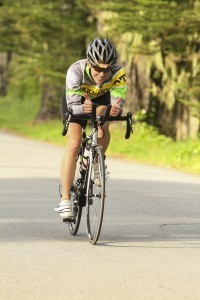
All good, now that the damn jacket is on!
A nine-mile bike course is so short it’s almost unremarkable, though. It was flat, and really narrow. I passed a lot of people, and didn’t get passed until the end, by a guy in really dirty shorts who slowed down right in front of me. Maybe his pride was already wounded by what appeared to be an accident of the excremental variety, but it seemed very important that he respond to being “chicked.” Sorry buddy. I had to pass you that second time. Your shorts were too gross.
I really enjoyed the run. Coach Raeleigh Harris has been conducting some excellent tri-specific track sessions on Thursdays, and I noticed a payoff in my stride. My legs felt fresh, and I kept an 8:04 pace for the 5K run. That’s my second-fastest ever. A few of the men passed me, as well as the Easter Bunny (seriously), but when a volunteer shouted that I was the fourth woman, I told myself not to lose focus. At the turnaround, I spotted one woman less than a minute behind me, and I promised myself that I’d hang on to my position until the finish line.
When the results were in, the fastest woman was an elite. I took third overall for age-groupers, and despite feeling a bit sheepish about choosing a shorter race, I had a great time. It was a pleasure to be out there, and I really enjoyed the excited faces of all the other athletes at the finish line and on the podium.
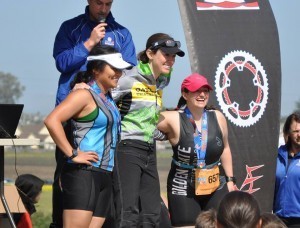
In the end, the only thing I wasn’t prepared for was the race photo of my swim exit. Since moving to the Bay Area, I’ve learned that the local waters have a traditional way of welcoming you. It’s kind of like a Hawai’ian lei, adorning swimmers with a sampling of the local flora. It’s called the Bay Beard, and it looks like a five o’clock shadow. It’s really the ugliest picture I’ve ever seen of myself in a wetsuit, which isn’t saying much. I only recognized myself by the way my wetsuit makes the jugular vein on the left side of my neck stick out.
So, bottom line: I was proud to tell my grandma about the victory, but I won’t be sending her the pictures.
April 4, 2014
“One time, at band camp…”
Somewhere along the paved slope of a road known ruefully as Nasty Grade, my wife Erin gasped these words over her handlebars. It took a minute, but the other dozen riders us–hypoxic and churning the pedals up the steep central Californian road–finally realized she was joking, and laughed. We’d been thinking the same thing: How can she possibly have enough breath to tell a story right now?
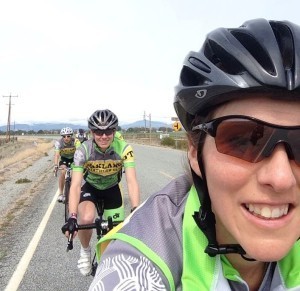
L to R: Christina Liebner, me, Erin Lopez
The ride was part of a three-day training camp with the Oakland Triathlon Club, a get-acquainted weekend with the drought-stricken landscape in California’s Monterey County. We will compete in the annual Wildflower Triathlon on May 2. The race is known as one of the most difficult; club member Trish Sampson once told me, “I’ve never done Wildflower and said afterward, ‘That went well.’” Coming from Trish, an Ironman Arizona finisher and four-time competitor in this race, it explains a lot about why the rest of the club wanted to preview the course.
This year promises to be especially challenging. When Erin raced it five years ago, there was water in Lake San Antonio. Now, about ten thousand athletes will swim in what’s left of it–a puddle by comparison, located 2.2 miles from the swim-bike transition area. It means that the 10K run usually reserved for the race’s final leg will be split in two: 2.2 miles before the bike, and 4 miles after it. And the general heat, hills, and pre-race hype will be the same as always, stoked by the mass of athlete campers who pitch their tents and fill the valley with our sport’s answer to Woodstock.

Dear Rain Gods: the lake goes here.
But for now, over a month before the race, the location is all but a ghost town. Our group of twenty-two athletes came together in four cabins along the dry lakebed, pretty much isolated from civilization except for another tri team further down the hill, a herd of deer, and a pack of coyotes who visited the camp at night. (The wild pigs, subject of a stern warning on the campsite fence, must have heard about triathletes’ legendary appetites in general, and our fondness for bacon in particular.) In short, we had one of the most popular triathlon courses in the world almost to ourselves.
Without its water to attract a boating and fishing crowd, the lake’s industry is in hosting triathletes: the swim course is already well-marked with signs to the shore, a map, and buoys. When Erin, Chris, Jessica, and I swam on a sunny Friday afternoon the water was cool but not uncomfortable; Saturday was cloudier, however, and the water was downright cold. I’ll at least pack earplugs with my race gear next month, but will probably skip the neoprene cap. Either way, expect extremely poor visibility underwater, and watch out for some quicksand along the shore. (Seriously!)
The Olympic course bike is very rolly, with two more significant hills just short of midway–though not nearly as painful as Nasty Grade on the long course. After the those two big ones on the way out, expect a smooth, slow, aero-bar-friendly descent to the turnaround, and an almost exact (smooth, slow) uphill on the way back into the rollers. The road is a little rough in places, but there is no need to fear the descents as long as your water bottles are secure.
And the 4-mile run… Well, after the short stretch of rolling road out of T2, there’s a hill. It’s called Beach Hill, and you’ve got a mile of sharp, steep switchbacks to play the rhyming game with that name all you want. And you will want. My advice: When you first see people running 200 hundred feet above you, you’ll know it’s right around the corner. Don’t get intimidated, and give your legs a few minutes to get used to the grade. Find a rhythm, and keep your mental composure. After you top out, there is a long downhill followed by more trail rollers–but by that point, you will probably be able to hear the finish line.
Although for us, last weekend, the only sound was the wind. Maybe helped along by this isolation, what struck me again about OTC is the speed of connection between people and the overwhelming friendliness of our group. Of course, we could bond over our shock at the dry lakebed, Nasty Grade, Beach Hill, and the joy of eating so many good meals. In fact, we hardly needed to talk about anything else. Yet aside from the particulars of conversation (which are plenty often arbitrary, anyway) there is a basic affinity that I feel comes from OTC’s best asset: its people.
And that’s why, as Erin and I made the three-hour drive back to Oakland on Sunday afternoon, just about every story we told started with, “One time, at tri camp…”
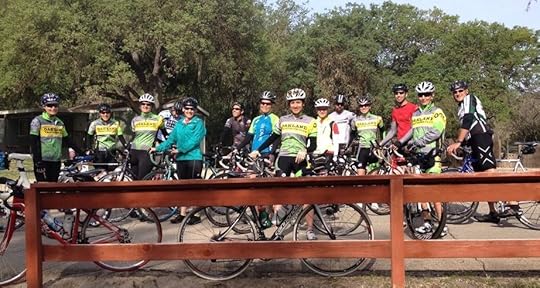
Thanks, OTC and Chris Van Luen, for a great adventure! (Photo by Jessica Russell)
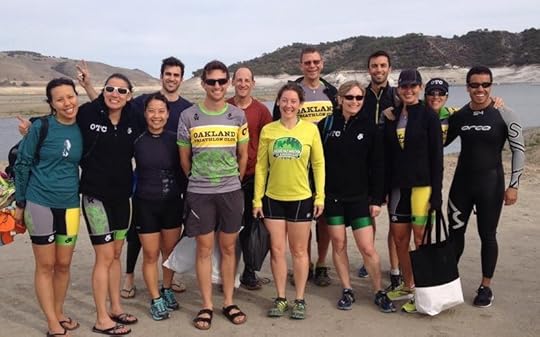
(Photo by Jessica Russell)
February 25, 2014
Starting Line: Thoughts on the 2014 Race Season
This week, the Oakland Triathlon Club announced its 2014 Elite Team. I’m extremely humbled to be a part of this group, which includes some of the Bay Area’s most promising athletes: Ian Ballentine, Christina Liebner, and coach Mitchell Reiss. We are already training for a very full season of Olympic-distance races: our top events include Wildflower, Escape from Alcatraz, and Oakland’s very first Oakland Triathlon.

Looking mean, in a very welcoming, OTC kind of way. (L to R: Mitchell, Ian, Christina, me)
Considering that my last triathlon was in 2009 or 2010 (it was that long ago), I’ve been training as if my life depended on it. In a week, I swim more than I did for the entire year and a half that I lived in Texas. I’m back to doing my pleasure reading on the bike trainer, and stealing glances at my Garmin every couple of minutes on my “relaxation” runs.
I’m also remembering that the nature of triathlon training is schizophrenic. Fitting two longish workouts into one day means suddenly shifting mental gears (and clothes) between desk and bike–two places where I give my all. Compartmentalizing never feels quite natural, but it’s a survival strategy for most age-groupers; unless, of course, your rich aunt just died and left you a hefty race stipend. Then, there’s a drive to get better that creates this urge to measure everything: heart rate, time per pool lap, length of a bike interval, last week’s running pace, the five-millimeter difference between one set of pedal cranks and another. One day at the gym, I caught myself counting sips at the water fountain, and wondered if all these numbers were literally making me crazy.
Yet, at least for me, I do all this counting with the understanding that triathlons are still totally relative. Lots of people are just going to be faster. And more important, there are athletes of all speeds whose dedication and pure heart for this sport completely humble me.
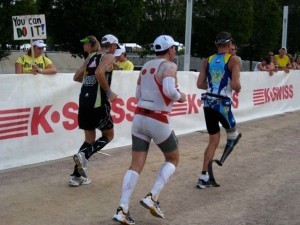
…Like this guy (on the right), who ran past as I was waiting for my wife to exit T2 at the 2011 Ironman Louisville.
And this is the spirit of what makes me so happy to race for the Oakland Triathlon Club. Besides being backed by some great sponsors, it’s THE most diverse group of athletes I have ever met. It’s California’s fastest-growing (and best!) triathlon club–and in my opinion, probably the most inclusive and friendly one on the whole planet. I can’t wait to push my physical limits with these folks this year, and continue to meet and write about our goals and accomplishments.
Here’s to a SAFE and HAPPY 2014 race season!
February 14, 2014
This Is Your Valentine
What matters to me on Valentine’s Day, what’s worth saying in a national storm of pink and red mylar balloons and overpriced greeting cards, is thank you. It has been a big year for love.
So, thank you for wearing a rainbow, even if you’re straight.
Thank you for painting Facebook red with HRC’s logo on March 26 and 27, the days when Supreme Court heard arguments in the Windsor and Prop 8 cases. This was purely coincidental with our wedding, but to us, it felt like the whole Internet had unknowingly sent us flowers.
Thank you, Mom and Dad, friends, and in-laws for coming to the wedding.
To the young Coast Guard yeoman, who processed my official spouse ID in September: as you waited for the card to laminate, you folded your hands under your chin and asked us, “So how did you meet?” My heart thanked you profusely because you saw the two of us women sitting there as nothing more or less than a love story to brighten up your morning.
Thank you to all the people who don’t miss a beat when I say wife.
Thank you for having our backs. For supporting us. For speaking up for us when our own voices shake. For reinvigorating the meaning of friendship. For loving us back.
This Valentine is for you.




